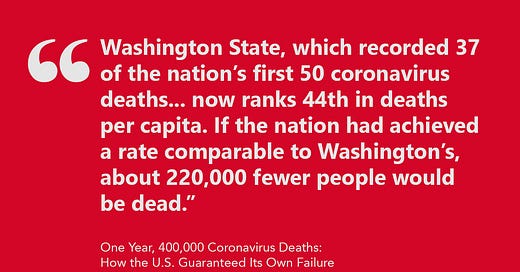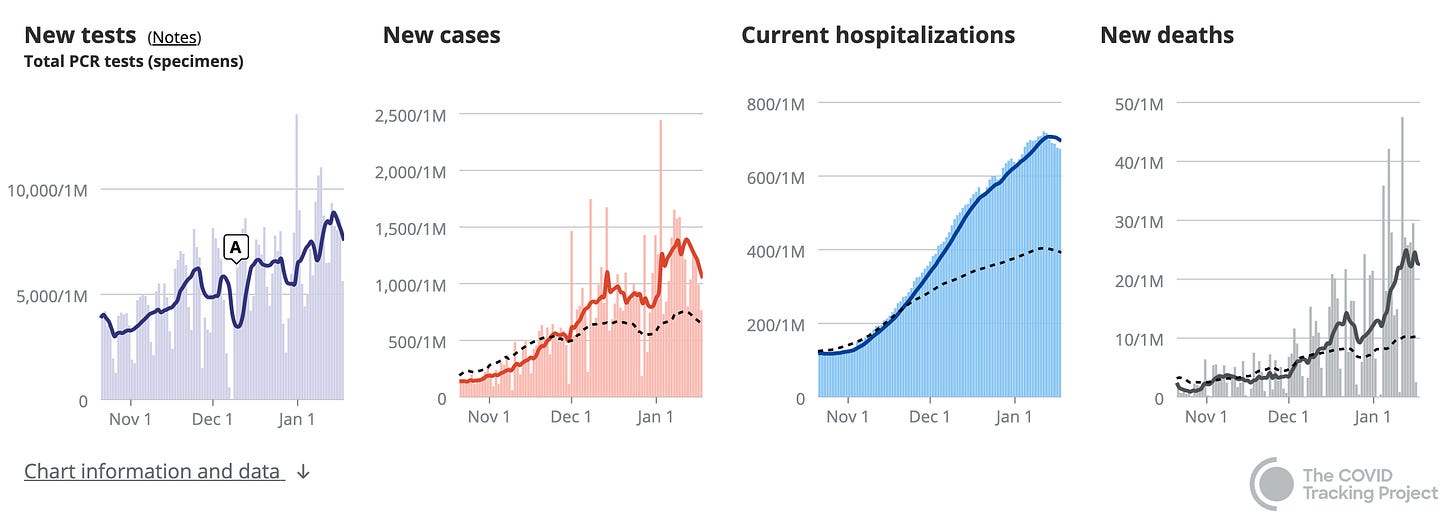COVID-19 day 364: 📈 Total US deaths approach 400,000; global deaths exceed 2 million : 18 January 2021
Had US matched Washington state death rate, US total deaths would be cut in half; US hospitalization rates appear to have plateaued; variant and vaccination updates, plus vaccine promises timeline
On 20 January 2021, Joe Biden and Kamala Harris will be sworn in as president and vice president of the United States, the 366th day after the first COVID-19 case was identified in the United States and South Korea. If time has seemed distorted for you this past year, an endless series of blursdays, Ruth Ogden’s essay may help with sense making.
Tragically, the US accounts for about 1-in-4 coronavirus cases and 1-in-5 deaths, although we represent less than 3% of the world’s population. At one point, it looked as though India (1.38 billion to our 331 million) would overtake us as the country with the world’s most cases. Instead, India got the virus under control and now has fewer than half as many cases and deaths as the United States.
States vaccinating the most residents on a per capita basis: Michigan, New Jersey, Florida, Indiana and New York, effective 15 January 2021.
More infectious variants have been detected in Brazil, Denmark, South Africa, and the United Kingdom, and they appear to have toeholds in the United States (CA, FL, MA, MI, NM, OR). “Appear to” because the US does not have a robust program for genomic testing of the virus. Kristian Andersen, a microbiologist at Scripps Research, told The Atlantic that we need a “federal mandate for genomic surveillance.”
Although US hospitalizations peaked at 132,474 on 06 January 2021 and have been declining slightly since the 12th, should a more infectious strain of the virus move through the United States, it could be calamitous. From the CDC:
“Higher rate of transmission will lead to more cases, increasing the number of persons overall who need clinical care, exacerbating the burden on an already strained health care system, and resulting in more deaths.”
A Troubling New Pattern Among the Coronavirus Variants. The Atlantic, 18 January 2021
Another New Covid-19 Variant Discovered In L.A. Might Be Vaccine Resistant, Researcher Says; Strain First Identified In Denmark. Deadline, 18 January 2021.
How British Scientists Found the More Infectious Coronavirus Variant. NY Times, 16 January 2021.
Inside the B.1.1.7 Coronavirus Variant (geek alert). NY Times, 18 Jan 2021
New coronavirus variants could cause more reinfections, require updated vaccines. Science Magazine, 15 January 2021.
UK supermarkets call for police to enforce mask wearing. World Economic Forum and Reuters, 18 January 2021.
18 January 2021
Washington state has one of the lowest death rates in the country (49/100K) and the lowest rate of all states with more than 4.3 million people. Only six states have a lower death rate (Hawaii, 1.4 million; Vermont, 624,000; Alaska, 732,000; Maine, 1.3 million; Oregon, 4.2 million; and Utah, 3.2 million). The New York Times:
Washington State, which recorded 37 of the nation’s first 50 coronavirus deaths, has kept in place a steadily adjusting suite of mitigation measures and now ranks 44th in deaths per capita. If the nation had achieved a rate comparable to Washington’s, about 220,000 fewer people would be dead.
Arizona has the worst infection rate in the country (as well as one of the worst in the world) and hit a record for new infections on Sunday the 10th, with 11,201 in a single day. On Friday, Arizona reported the most cases since then, 9,146.
According to the Wall Street Journal, 60% of those hospitalized in Arizona have COVID-19 and those patients occupy about 65% of intensive care unit beds; the state's positivity rate is 16%; and health officials estimate 1 in 10 residents is currently infected. The US goal is a 10% positivity rate before “opening up” the economy; the WHO goal is a 5% positivity rate.
“We’re the hottest spot in the U.S. and among the hottest spots in the entire world,” said Keith Frey, chief medical officer for hospital chain Dignity Health’s Arizona division. “If we don’t slow this down over the course of the next days and weeks, then we will be fully into that crisis zone.”
In California, the Los Angeles County Department of Health Services has estimated that about one in three people in the county have been infected since last January.
A few reads
😷 5 Reasons to Wear a Mask Even After You’re Vaccinated
⚠️ Covid Cuts Average Life Expectancy By 1 Year — More If You’re Black Or Latino
🍑 Deep South falls behind in coronavirus vaccine drive
🥕 From a landfill site to an urban farm: The transition that kept a Thai city fed during COVID-19
🖥 Vaccine registration technology is failing. Here’s how the Biden administration could fix it
🦠 Watch: How - and why - coronaviruses mutate
💉 What to expect when you’re injected: Vaccine side effects explained
Where are we today?
US vaccines
A vaccine promises timeline (both US-approved vaccines require two shots)
“We expect to have 100 million doses of vaccine available certainly before the end of the year.” Trump, 18 July 2020
“We will have manufactured at least 100 million vaccine doses before the end of the year… we expect to have enough vaccines for every American by April.” Trump, 18 September 2020.
“We will deliver 100 million doses of a safe vaccine before the end of the year, and maybe quite a bit sooner than that.” Trump, 26 October 2020.
“We plan to have enough vaccine doses available for use in the U.S. population to immunize about 20 million individuals in the month of December and another 25 to 30 million per month on an ongoing bases from there on.” HHS program director, Slaoui, 13 November 2020. This would have meant 20 million doses in the state officials hands the first week and another 20 million starting the third week.
“We expect … to have 40 million doses, covering 20 million Americans, by the end of December.” HHS Secretary Azar, 03 December 2020.
20 million Americans will have been vaccinated by the end of December. Pence, 10 December 2020. The implication is two shots but given the date, that can only be one shot.
FDA authorized the first coronavirus vaccine on 12 December 2020.
According to the NYTimes, on 17 December, officials in California, Connecticut, Idaho, Iowa, Massachusetts, Michigan, Minnesota, New Jersey, Nevada, Oregon, Vermont, Virginia, Washington, and Wisconsin found out that this week’s shipment of the vaccine will contain fewer doses than promised. Of these 14 states, 12 voted Democratic in November. (Idaho and Iowa are the exceptions.)
Moderna began shipping its COVID-19 vaccine in U.S. on 20 December 2020.
HHS Secretary Azar announced on 12 January that the federal government would begin releasing vaccine doses to the states that had been held in reserve for second shots; however, any such reserve that might have existed had been exhausted. States will get no additional doses this week. 15 January 2021.
US deaths
Deaths over a rolling seven-day period peaked at 23,357 on Saturday 16 January 2021. This is a 23% increase over the prior peak of 18,992 deaths on Tuesday 22 December 2020 (Covid Tracking Project plus current ID/NE/WA data, as they are reported a day late by CTP).
Johns Hopkins reported a total of 398,981 US deaths and 24,074,200 cases on Monday 18 January 2021, a holiday. Some states reported data publicly: 334,897 news cases and 3,440 new deaths. The seven-day average from those state reporting over a holiday weekend: 236,944 daily cases and 3,556 daily deaths.
Globally, Johns Hopkins and the World Health Organization reported more than 2,000,000 deaths on Monday (2,040,285 and 2 026 093, respectively). Cases, 95,555,533 and 93 805 612.
US cases, COVID Tracking Project
States with the most new cases (seven-day average):
Arizona, 105/100K
South Carolina, 96/100K
California, 95/100K
Utah, 80/100K
Texas, 79/100K
States with the fewest new cases (seven-day average):
Hawaii, 10/100K
North Dakota, 21/100K
Michigan and Minnesota, 25/100K
Vermont, 26/100K
Iowa and Oregon, 28/100K
US hospitalizations, COVID Tracking Project
Key metrics
🦠 Friday, 15 January 2021, Johns Hopkins reported 23,524,081 (216,849 new) cases and 391,955 (3,422 new) deaths in the US, an increase of 0.93% and 0.88%, respectively, since Thursday. A week ago, the daily numbers increased by 1.23% and 0.99%, respectively.
The seven-day average: 237,330 cases and 3,312 deaths
Case rate is 710.7 per 100,000; the death rate, 118.4 per 100,000. One week ago, the case rate was 660.5 per 100,000; the death rate, 111.4 per 100,000.
Hospitalizations: total of 127,235 compared to 130,777 one week ago.
Vaccinations: 12,279,180 with 31,161,075 doses distributed to the states. One week ago, 6,688,231 with 22,137,350 doses distributed
Note: the seven-day average is important because dailies vary due to factors other than actual case numbers, particularly over a weekend.










